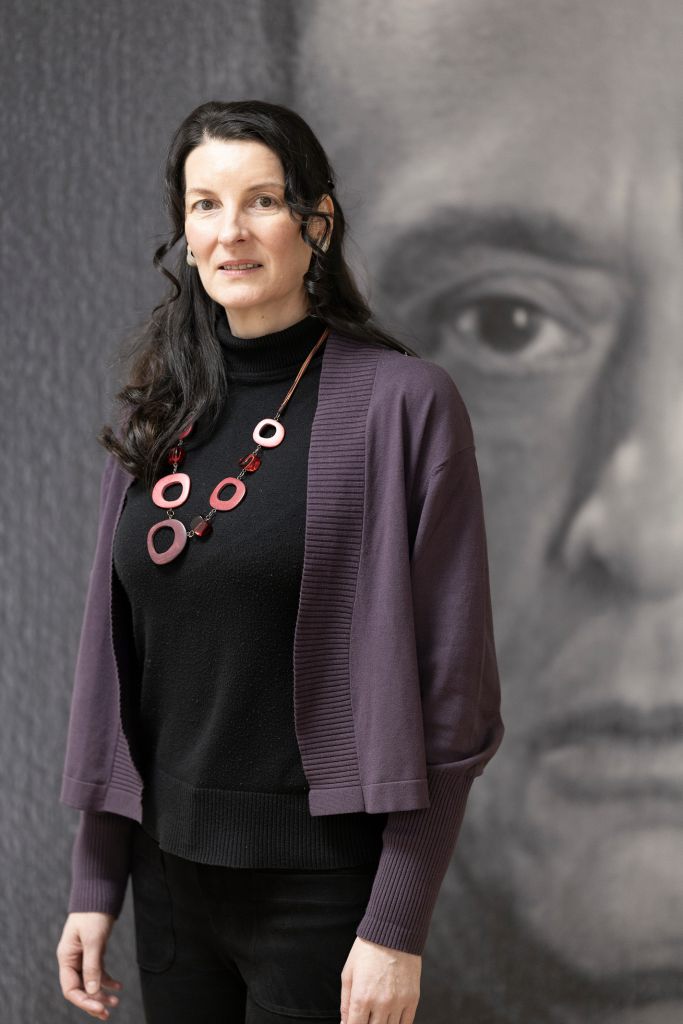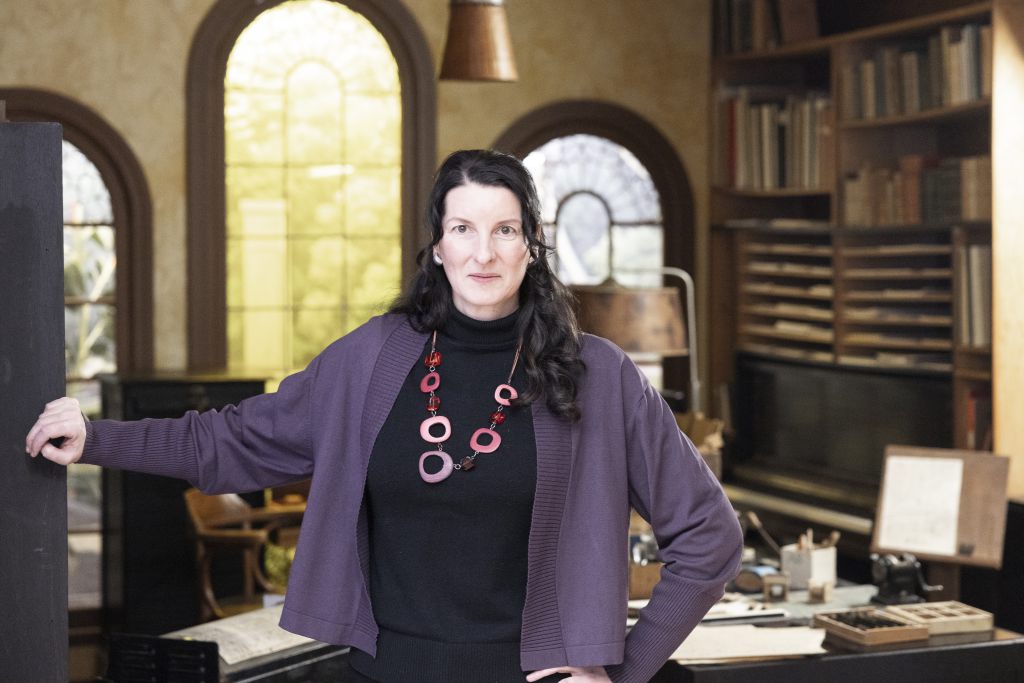2024 wird 150. Geburtstag gefeiert: Zahlreiche Veranstaltungen würdigen Arnold Schönberg, Universalkünstler und Wegbereiter der musikalischen Moderne, in seinem Jubiläumsjahr. Ihr einjähriges Jubiläum begeht Ulrike Anton als Direktorin des Arnold Schönberg Center Wien.
Sie sind seit März 2023 Direktorin des Arnold Schönberg Center, wie fällt Ihr Resümee über Ihre bisherige Amtszeit aus?
Ulrike Anton (UA): Zuerst einmal ist es eine große Freude und Ehre, Direktorin dieses Hauses zu sein. Das Arnold Schönberg Center hat in den letzten 25 Jahren seit seiner Gründung sehr viel geleistet, sowohl was die Wissenschaft betrifft, die Ausstellungstätigkeit als auch die Konzertveranstaltungen. Bezüglich der Vermittlung des Lebens und Werks Schönbergs kann das Arnold Schönberg Center aus dem Vollen schöpfen und auf eine spannende Zeit zurückblicken. Umso erfreulicher war es für mich, kurz vor Beginn des Jubiläumsjahres, Schönbergs 150. Geburtstag 2024, als Direktorin einzusteigen. Ich bin mit offenen Armen vom fantastischen Team aufgenommen worden, das mit Herzblut dabei ist und mich sehr unterstützt. Und das kommt auch meinem Wesen entgegen, da ich jede Aufgabe, die ich übernehme, mit großer Leidenschaft mache. Von März 2023 bis jetzt war das eine intensive Phase, in der wir vermehrt Schönberg in die Stadt Wien brachten. Dabei konnten wir erfolgreich Netzwerke mit anderen Häusern und Institutionen knüpfen und teilweise neue Kooperationen aufbauen. Die Früchte dieser Bemühungen zeigen sich nun im Verlauf des Jahres 2024 und sicher darüber hinaus.

2024 steht ganz im Zeichen des Jubilars Arnold Schönberg – was ist alles geplant?
UA: Für die erste Jahreshälfte wurden unter dem Label Schönberg 150 in Wien und Umgebung (das Schönberg-Haus in Mödling gehört auch zur Stiftung) 129 Veranstaltungen von 26 Partner_innen an 16 verschiedenen Orten vereint. Gemeinsam mit Wien Modern hat das Arnold Schönberg Center im Auftrag der Stadt Wien die Koordination übernommen. Wichtige Kooperationspartner_innen sind der Musikverein Wien, Superar oder das MusikTheater an der Wien, um nur einige zu nennen. Am Center selbst freuen wir uns u. a. auf ein Festkonzert mit Mitgliedern der Wiener Philharmoniker sowie auf zwei neue Ausstellungen zum Jubiläumsjahr, kuratiert von Therese Muxeneder. In Zusammenarbeit mit der mdw finden eine ganze Reihe von Konzerten, Performances und wissenschaftlichen Formaten statt. Höhepunkte darunter sind der Besuch des Arditti Quartet anlässlich seines 50-jährigen Bühnenjubiläums mit einer öffentlichen Masterclass an der mdw sowie einem Konzert am Arnold Schönberg Center, das Konzert des Webern Ensemble Wien mit Schönbergs Suite op. 29, der Studientag zu Schönberg und Nono oder das Projekt Verklärte Nacht Unveiled mit einem Vortrag von Eike Feß.
Wie fließen Ihre bisherigen beruflichen Erfahrungen in Ihr jetziges Aufgabenfeld mit ein?
UA: Durch meinen Werdegang als Flötistin und mein Spezialgebiet der Exilmusik bin ich vernetzt, das kommt mir bei meiner vielfältigen Arbeit hier zugute. Das Herzstück des Arnold Schönberg Center ist das Archiv, seit 25 Jahren beherbergt es den Nachlass von Schönberg; dann kommen natürlich die Konzerte hinzu mit ihrer Programmgestaltung. Ein weiteres Herzensthema sind mir die Schönberg-Schülerinnen, darunter u. a. Vilma von Webenau und Dika Newlin, die sichtbarer gemacht werden sollen, es gibt eben nicht nur die „Schüler“ Schönbergs. Außerdem haben wir auch österreichweite (Kulturhauptstadt Salzkammergut 2024 u. a.) und internationale Kooperationen, die durch weltweite Ausstellungen sichtbar werden, z. B. am Theater Bonn oder in der Berliner Philharmonie sowie an den Österreichischen Kulturforen. Persönlich ist es mir besonders wichtig, die Vermittlungsschiene auszubauen und in die Stadt zu tragen, da gab es Gespräche mit der Bildungsdirektion für Wien und den Wiener Volkshochschulen, die ja das Projekt LEARN TO HEAR in Kooperation mit dem Institut für musikpädagogische Forschung, Musikdidaktik und Elementares Musizieren der mdw in ihr Programm aufgenommen haben. In Zusammenarbeit mit Superar gibt es unser Kindervermittlungsprogramm und Schönberg-Schwerpunkte in Konzerten.

Es ist ein breites Spektrum, dass das Arnold Schönberg Center in seinem Wirken abdeckt. Haben Sie einen Lieblingsplatz hier oder ein bevorzugtes Ausstellungsstück?
UA: Als Flötistin liegt mir das Bläserquintett von Arnold Schönberg sehr am Herzen. In unserer letzten Ausstellung war die berühmte Drehscheibe zu sehen, die zur Ausarbeitung des Zwölftonwerkes diente. Das ist ein besonderes Objekt für mich. In der Ausstellung wurde versucht zu vermitteln, dass die Zwölftontechnik im Laufe eines langen Prozesses entstanden ist und von Schönberg ständig weiterentwickelt wurde. Wie Schönberg selbst seinen Schüler_innen gesagt hat: „Man muss immer auf der Suche bleiben!“
Bei Arnold Schönberg denken viele als Erstes an die Zwölftontechnik, aber er lässt sich darauf nicht beschränken, für ihn war das nur Grammatik, die inhaltliche Aussage wichtiger.
UA: Genau, die Methode ist für ihn nur Mittel zum Zweck, der Ausdruck ist das Wesentliche. Das war auch eines meiner Schlüsselerlebnisse beim Versuch, mich Schönberg anzunähern. Ich habe an der mdw während meiner Doktoratsstudienzeit Richard Hoffmann kennengelernt, den letzten Assistenten Schönbergs. Er hat sehr lebendig erzählt, wie Schönberg praxisnah unterrichtete, und dass er sehr gut und einfach erklären konnte. Immer war die Expressivität in der Interpretation seiner Werke das Wichtigste, nie – worüber es ja immer wieder Vorurteile gibt –, dass es technisch und mathematisch errechnet wäre. Das wurde mir besonders eindrücklich in einer Lehrstunde von Richard Hoffmann vermittelt und ist seitdem in meinem Gedächtnis geblieben. Und das heißt, wenn man Musik mit Zwölftonmethode hört oder selbst spielt, dass man in jedem Intervall einen Ausdruck zu finden versuchen muss, das ist das Zentrale der Methode.
Und vor diesem Erlebnis in Ihrer Studienzeit: Wissen Sie noch, wann Sie zum ersten Mal bewusst mit Schönbergs Werken in Berührung gekommen sind? Gab es ein prägendes Hörerlebnis?
UA: Mein allererstes bewusst wahrgenommenes Werk von Schönberg war Ein Überlebender aus Warschau, das mein vier Jahre älterer Bruder bei seiner Musik-Matura als Thema hatte. Er hat es auf der Stereoanlage zu Hause oft gehört, und ich habe die politische Dimension der Thematik erfasst. Das Werk hat mich sehr berührt. Ich habe mir das schon für mich so erklärt, dass man dieses inhaltliche Thema nicht mit einer wunderschönen Melodie ausdrücken kann, auch wenn ich natürlich noch nichts von Zwölftonmethode oder Ähnlichem wusste.
Haben Sie ein Lieblingswerk von Arnold Schönberg? Und was würden Sie ihn fragen, wenn Sie eine Stunde mit ihm reden könnten?
UA: Ja, sein Violinkonzert ist ein für mich faszinierendes Werk. Und als Flötistin würde ich ihn natürlich fragen, warum er kein Flötenkonzert geschrieben hat. Die Flöte spielt zwar in Pierrot lunaire eine große Rolle und kommt im Bläserquintett vor, aber es könnte mehr sein an Bläserkammermusik, und ein Solokonzert wäre natürlich auch schön. Ein weiteres faszinierendes Werk ist für mich Das Buch der hängenden Gärten. Gerade bei Schönberg muss man die Stücke öfters hören und vor allem mehrmals bewusst im Konzert erleben.
Und welches Werk würden Sie jemandem empfehlen, der Schönberg bisher nicht kennt, was sollte man sich als Erstes anhören?
UA: Auf jeden Fall Verklärte Nacht! Das ist harmonisch zugänglicher. Und die Kammersymphonie Nr.1 op. 9, die war auch für Arnold Schönberg ein wirklicher Wendepunkt in seinem Kompositionsstil, bei dem diese sukzessive „Emanzipation der Dissonanz“ schon deutlich wird. Also das wären so die beiden „Einsteiger_innenwerke“.
Schönberg ist ja nicht nur als Komponist bekannt, er hat in vielen Kunst- und Lebensbereichen Bedeutendes geschaffen.
UA: Ja, das ist sicherlich eine weitere Faszination, die von ihm ausgeht, dieser unglaublich große und wache Geist. Dass er eben nicht nur Komponist war, sondern Maler, Lehrer, Erfinder, Theoretiker und vieles mehr. Man hat das Gefühl, wenn er nicht komponiert hat, musste er gleich etwas anderes machen, zum Beispiel einen Umsteigeplan für die Berliner öffentlichen Linien erfinden. Oder ein Schachspiel oder ein Reise-Roulette, das sich im Archiv des Arnold Schönberg Center befindet. Es ist diese Kreativität, die ständig da war. Seine Tochter Nuria Schönberg Nono erzählt die Geschichte, dass es außer dem Arbeitszimmer einen Raum gab, in dem alle technischen Erfindungen standen. Das wäre spannend zu sehen, wie sich Arnold Schönberg in der heutigen Welt fühlen würde. Er wäre sicherlich allen neuen Medien und Techniken gegenüber aufgeschlossen. Das passt zu einem unserer Höhepunkte im Jahr 2024, der Präsentation des Virtual Reality-Game zu Schönbergs Erwartung vom Staatstheater Augsburg, die im Februar bei uns stattgefunden hat. Die hätte Schönberg unglaublich gut gefallen. Bei den meisten Konzerten im Arnold Schönberg Center werden neben Werken von Arnold Schönberg auch Verbindungen zu anderen Kompositionen hergestellt. Sei es jetzt im Rückblick, also in Kombination mit der Wiener Klassik oder mit Werken von Schönbergs anderen Vorbildern wie Johannes Brahms oder Gustav Mahler, oder – wie vermehrt auch im Jubiläumsjahr 2024 – in die Zukunft gewandt. Wie beziehen sich Komponist_innen von heute auf Schönberg? Wir freuen uns ganz besonders, dass es hierzu in Kooperation mit der mdw das Komponistinnenporträt mit Olga Neuwirth geben wird. Also dass eben die Musik, die heute komponiert wird, auch im Arnold Schönberg Center ein Zuhause hat.

